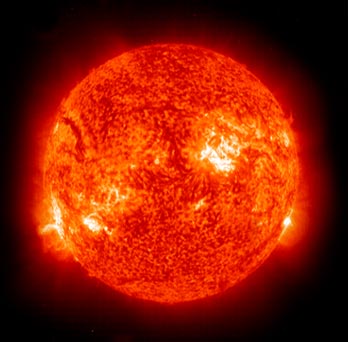Background information on NASA’s Living
with a Star initiative
| |
 |
| |
This
solar image was taken by the Extreme Ultraviolet Imaging Telescope
aboard NASA's Solar and Heliospheric Observatory (SOHO) spacecraft.
|
Reliable, constant, unchanging. This is the
way we think about our Sun. An ‘old faithful’ source
of energy and heat. The Inca thought that the Sun has the power
to makes things grow. And it does. But research has shown us that
the Sun is a tremendously violent, variable, magnetic star whose
activity affects the Earth and planets in fundamental ways. The
Earth is constantly bathed by the solar wind, a stream of charged,
high-speed particles traveling at an average of 250 miles (~400
km) per second. Thus the Earth is physically within the atmosphere
of the Sun. The solar wind shapes the Earth’s magnetosphere,
and solar magnetic storms and massive particle ejections from
the corona affect the Earth, and can disrupt communications, damage
satellites, and even cause blackouts.
Total solar eclipses gave scientists early clues about the active
nature of the Sun, by allowing researchers to see and study the
Sun’s corona, which is typically hidden by the bright solar
photosphere that gives rise to the Sun’s visible light. The
corona is composed of tenuous, million degree gas, much hotter
than lower layers of the Sun’s atmosphere, and harbors much
of the Sun’s activity. Since it is physically impossible
to transfer thermal energy from the cooler surface of the Sun
to the much hotter corona, the source of coronal heating has been
a scientific mystery for more than 60 years. This and other research
questions continue to puzzle scientists, who are now able to use
sophisticated satellite instrumentation to observe the corona
and study the activity of the Sun—striving to understand
the consequences of “Living with a Star.”
Living with a Star (LWS) is a NASA initiative that addresses aspects
of the Sun-Earth system that affect life and society. As the sphere
of the human environment and exploration continues to expand towards
space, understanding the effects of our active Sun and ‘space
weather’ on astronaut safety, satellite operations, power
and communications, and climate change become critical research
priorities. We need to understand and be able to predict the effects
of solar activity on Earth and society. Just as satellites help
us better understand changes in weather around our Earth, a "Living
With a Star" constellation of satellites will help us better
understand how our star can affect many of the advanced technologies
we have become so dependent on for everything from economic livelihood
to national defense. LWS will provide the data necessary for advanced
warning of solar energetic particle showers that affect the safety
of humans in space. It will improve our understanding of the effects
of solar variability and disturbances on terrestrial climate changes,
and will provide information useful in the design of more reliable
electronics for air and space transportation and communication
systems.
Total eclipses have, over the years, provided a unique opportunity
to see our Sun ‘in a different light’ from the portrayal
of the Sun as a constant and relatively tame source of heat and
energy. NASA solar research has enabled scientists to understand
the consequences of solar storms and space weather on all aspects
of the human endeavor—from a person relying on a pager for
communication to astronauts in space.
 Learn more about Living
with a Star on the NASA Web site.
Learn more about Living
with a Star on the NASA Web site.
 Learn more about Sun-Earth
Connection on the Sun-Earth Connection Education Forum Web
site.
Learn more about Sun-Earth
Connection on the Sun-Earth Connection Education Forum Web
site.
